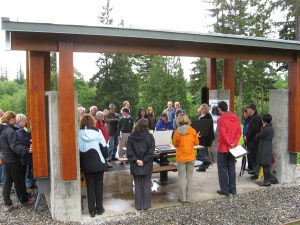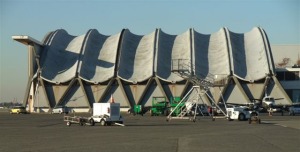8 Historic Properties on 2010 Most Endangered List
About thirty people gathered under a picnic shelter in a Sammamish park on June 2 for the unveiling of the 2010 Most Endangered Historic Properties List. The drizzly weather did not stop preservation stalwarts from coming to this annual press event produced by the Washington Trust for Historic Preservation, which has been administering the Most Endangered program since 1992. Representatives from the sites spoke to the value of the resources that are endangered and why they are important in their communities. The list highlights Washington’s state’s diverse properties. The purpose of the list is to raise awareness of the challenges and opportunities facing historic resources across the state and to encourage collaboration with all stakeholders to develop preservation strategies.
Following is this year’s list of Most Endangered Historic Properties (in no particular order of importance). Photos of each property may be viewed on the Trust’s website.
Reard Freed Farmhouse, Sammamish
Once part of a now-lost 80 acre farmstead, the 1890s farmhouse is the last remaining building of the former agriculture complex. After 1915, the house is remembered as being a gathering place for the community with dances held in the large room on the 2nd floor. It is ready to be moved but is threatened by lack of funding to pay for the relocation and needed restoration. Demolition of the Reard Freed Farmhouse would result in the loss of one of the very few early historic structures that help tell the story of the Sammamish Plateau. The other seven historic properties being named to the Most Endangered List are:
Coke Oven Park, Town of Wilkeson
The coke ovens are the only evidence left to tell Pierce County’s coal industry story of the boom time in “uptown” Wilkeson. The Tacoma Coal & Coke Co. built the first 25 beehive coke ovens at Wilkeson in 1885, and 50 more ovens were added in 1891. By 1902, 100 ovens were in constant use and 160 ovens lined the road to uptown Wilkeson. Coke was then shipped to ports as far as San Francisco and Alaska. Coke production reached a maximum of 125,872 tons in 1916, then declined steadily until production terminated in 1937. The mine shafts were sealed, and other buildings removed. The ovens are listed in the National Register of Historic Places, the Washington Heritage Register and Pierce County Register, and today are threatened with lack of protection from vandalism, neglect and vegetation overgrowth.
Moran School Administration Building, Bainbridge Island
Constructed in 1918 by Frank Moran, the Moran School for Boys was built on 40 acres at Skiff Point, near Rolling Bay, 4 miles north of Winslow with views of Seattle and Mt. Rainier. The school closed in 1933, but the property was purchased by Joseph Hill five years later and re-opened as Puget Sound Naval Academy – a military prep school readying boys for the Coast Guard Academy and U.S. Naval Academy. When the naval academy closed in 1951, one building was retooled as a nursing home, now known as Messenger House. A second building, the Administration Building, has stood empty since that time, save for a brief transformation into a movie set in 2000. The owner of the historic school has sought a demolition permit from the City of Bainbridge Island to remove the Administration Building, citing the high costs of rehabilitation and the lack of a viable use for the structure.
Murray and Rosa Morgan House, Auburn
Originally constructed as a community dance hall, the house stands as one of the few remaining buildings from the era of small lakeside resorts common to that part of King County in the 1920s and 30s. Names of courting couples are still carved into the log supports of the porch, and the fireplace where they warmed up is still in use. With peeled log for the beams, old-growth fir floors, pine paneled walls and a big masonry fireplace, the original building represents a style of Northwest vernacular architecture for outdoor recreation. Of greater significance is that Murray Morgan, a preeminent and popular Northwest historian of the 20th century, as well as an influential journalist, drama critic and teacher, lived and worked in the Trout Lake home from 1947, shortly after his Army service in World War II, until his death in 2000. This home is where Murray Morgan wrote his books and magazine articles, prepared his lectures, and broadcast his daily radio show. Plans are underway to conserve the land on which the house is located, but rehabilitation costs and other issues may hinder efforts to preserve the house.
National Historic District, Roslyn
The City of Roslyn is a National, State and Local Historic District consisting of approximately 900 property lots and 600 residential, commercial and community structures. Many structures suffer from deferred maintenance and neglect, in some cases resulting in demolition. Too often, new buildings constructed adjacent to existing structures fail to be compatible with the historic character of the town. Furthermore, the Historic District is endangered by the continuing loss of the thousands of acres of forested perimeter surrounding the town. Sales of forest land to private investors and development companies have already affected Roslyn’s historic resources. For example, a January 2009 mudslide originating from cleared forest lands above the town damaged buildings and roads. Without consideration to the town’s historic core, additional development, if unchecked, may continue to erode the historic fabric that makes Roslyn one of Washington’s truly unique and significant historic centers.
Skykomish Hotel, Skykomish
The Skykomish Hotel, part of a historic district listed in the National, State and Local registers, was rebuilt to four stories shortly after a 1904 fire devastated the town. Costing $10,000, the new hotel featured chandeliers, a fireplace, gambling room/bar and restaurant. The town shrank from 18,000 to 800 by the 1950s, although the historic core remained. Today, a massive environmental remediation effort by the railroads is giving the historic structures in Skykomish a potential shot in the arm – all the structures remaining in Skykomish are being raised, de-contaminated, and re-sited on new foundations. While property owners hope this work can serve as a catalyst for revitalization, the Skykomish Hotel has remained vacant and largely neglected for several years. One of the town’s most prominent buildings, further inattention will likely lead to insurmountable maintenance needs, leaving demolition as the only option.
Trafton Elementary, Arlington
The Trafton School is one of the oldest continually operating public schools in the state, having first been established in 1888 when Washington was still a territory. With the original schoolhouse succumbing to fire, the current school building, built in 1912, is located in a unique rural country setting and retains its original architecture, accented with its bronze school bell in an open cupola on the roof. The building is on the National Register of Historic Places and the Washington Heritage Register and received a Snohomish County Historic Preservation Commission Award. The Arlington School District Board, facing district-wide under-enrollment, budget deficits, and needed repairs to Trafton, will vote on June 14 whether or not to keep Trafton’s doors open. The hope is that Trafton will remain open and continue to serve the community as it has for over 120 years.
Quad 7 Hangar (West Coast Airlines Hangar), Boeing Field, King County
Quad 7 Hangar was constructed in 1962 for West Coast Airlines. The structure was designed by John Morse of Bassetti & Morse, one the most prominent architecture firms in the Pacific NW during the mid-twentieth century. As the firm dissolved in April 1962, the hangar constitutes one of the firm’s last projects. The engineering firm was Skilling, Helle, Christiansen and Robertson. Jack Christiansen, one of the firm’s principals, is best known for his work on thin-shell concrete structures and was considered a world leader in their design. Today, the hangar is used to service and outfit small jets and planes catering primarily to corporate clients. Demolition is planned by the current tenant (who leases the property from King County). Re-development plans for the site include construction of seven new hangars.

